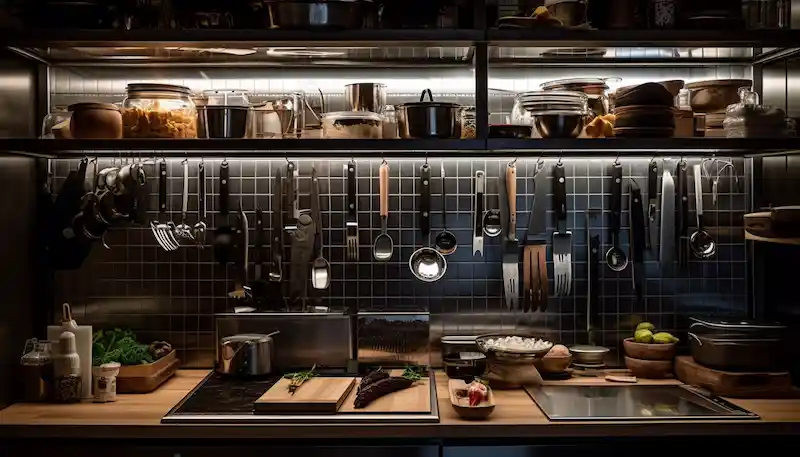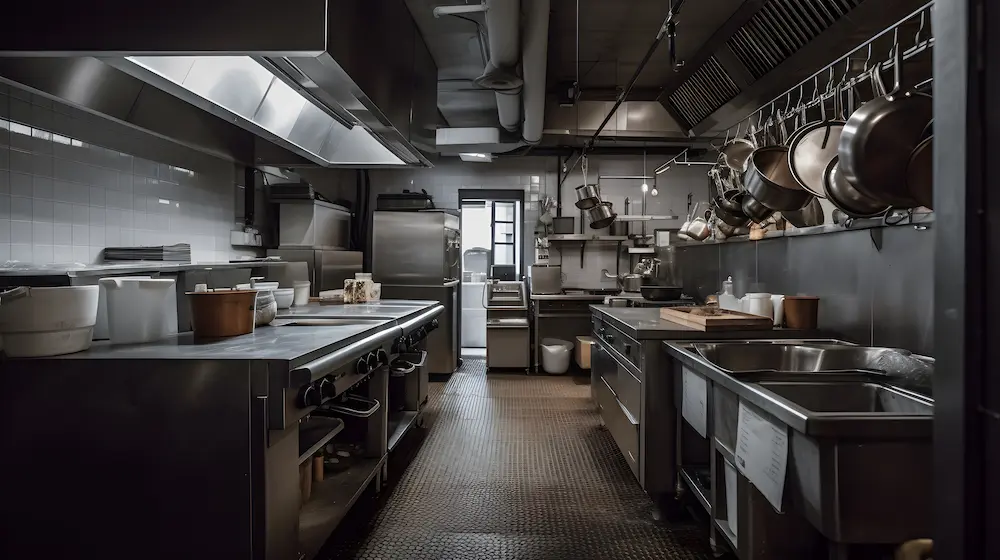A commercial kitchen is where food is prepared, cooked, and served to customers. Designing a commercial kitchen requires careful planning, research, and creativity. Here are some tips and principles on how to design a commercial kitchen that is efficient, tasteful, and sustainable:
Choose the Right Layout
The layout is how the equipment, furniture, and workstations are arranged in the kitchen. The layout should facilitate the workflow and the movement of the staff and the materials. It should also optimize the use of space and resources, and comply with the health and safety regulations.
There are different types of layouts, such as island, zone, and assembly line. The best layout depends on the type, size, and volume of the food service business, as well as the budget and preferences.
Utilize Space Wisely
It is important to utilize the space wisely and avoid any wasted or unused space. This can help you to:
- Maximize the storage capacity: You can use vertical space, such as wall-mounted shelves, racks, and cabinets. You can also use multi-purpose and modular furniture, such as tables, carts, and counters, that can be moved and adjusted according to your needs.
- Optimize the workstations: You can use the right size and shape of the equipment and furniture, and place them in the optimal position and distance. You can also use mobile and flexible workstations, such as carts, tables, and cutting boards, that can be moved and adapted to the workflow and the layout.
- Enhance the aesthetics: You can use the right colour, lighting, and decoration. You can also use natural and sustainable materials, such as wood, stone, and metal, that can add warmth, texture, and character to the kitchen.

Use the Right Equipment
The equipment is the tools and machines that are used to prepare, cook, and serve the food. The equipment should be reliable, durable, easy to use and maintain, energy-efficient, water-efficient, and eco-friendly. Using the right equipment can help you to:
- Improve the quality and consistency of the food: The equipment should be able to produce high-quality and consistent food, according to the standards and specifications of the food service business. It should also be able to handle the volume and variety of the food and meet the expectations and preferences of the customers.
- Reduce the operating costs and the environmental impact: The equipment should be able to consume less energy, water, and resources, and produce less waste, emissions, and noise. This can help you to save money and reduce your environmental impact.
- Increase the safety and hygiene of the kitchen: The equipment should be able to prevent and control the risks of fire, injury, and contamination in the kitchen. It should also be easy to clean and sanitize and meet the health and safety standards and regulations.
The best equipment depends on the type, size, and volume of the food service business, as well as the budget and preferences. You can also use smart and innovative equipment, such as automated, robotic, and digital equipment, that can enhance the efficiency, productivity, and quality of the food service operation.

Add Automation
Automation is the use of machines and systems to perform tasks that normally require human intelligence, such as learning, reasoning, and decision-making. Automation can be applied to various aspects of the food service operation, such as ordering, inventory, production, delivery, and service. Adding automation can help you to:
- Reduce human errors and improve accuracy: Automation can reduce errors and delays in the ordering, inventory, production, delivery, and service processes, and improve customer satisfaction and loyalty.
- Optimize the workflow and the performance: Automation can reduce the labour costs and the workload of the staff, and improve the efficiency and the quality of food production and service.
- Enhance the customer experience and engagement: Automation can offer personalized and customized food products and experiences to customers, and create a unique and memorable dining experience.
Utilize Lighting
Lighting is the use of natural or artificial light to illuminate the space and the objects in the kitchen. Lighting can have a significant impact on the mood, the atmosphere, and the functionality of the kitchen. Utilizing lighting wisely can help you to:
- Improve visibility and safety: You can use bright and uniform lighting, such as LED or fluorescent lights, that can provide adequate and consistent illumination for the staff to perform their tasks. You can also use task lighting, such as spotlights or lamps, that can focus on specific areas or equipment.
- Create the ambience and the mood: You can use dimmable and adjustable lighting, such as halogen or incandescent lights, that can change the intensity and the colour of the light according to the time of the day, the season, or the occasion. You can also use decorative lighting, such as candles, lanterns, or fairy lights, that can add warmth, charm, and character to the kitchen.
- Save energy and money: You can use energy-efficient and eco-friendly lighting, such as LED or solar lights, that can consume less electricity and last longer than conventional lights. You can also use natural lighting, such as windows, skylights, or mirrors, that can allow the sunlight to enter and illuminate the kitchen.
Implement an Environmental Plan
An environmental plan is a set of policies and practices that aim to reduce the environmental impact of the food service operation. An environmental plan can cover various aspects, such as sourcing, waste management, and energy management.
Conclusion
Designing a commercial kitchen is a complex and challenging task, but it can also be rewarding and satisfying. A commercial kitchen that is efficient, tasteful, and sustainable can improve the quality, efficiency, and profitability of the food service business, and create a positive impact on the staff, the customers, and the environment.
Designing a commercial kitchen is a complex and challenging task, but it can also be rewarding and satisfying. A commercial kitchen that is efficient, tasteful, and sustainable can improve the quality, efficiency, and profitability of the food service business, and create a positive impact on the staff, the customers, and the environment. If you need professional help with designing and implementing food service facilities for various industries and sectors, as a Commercial kitchen designers, Kilowa Design can help you achieve your goals through innovative and sustainable solutions customized to your needs and budget.







